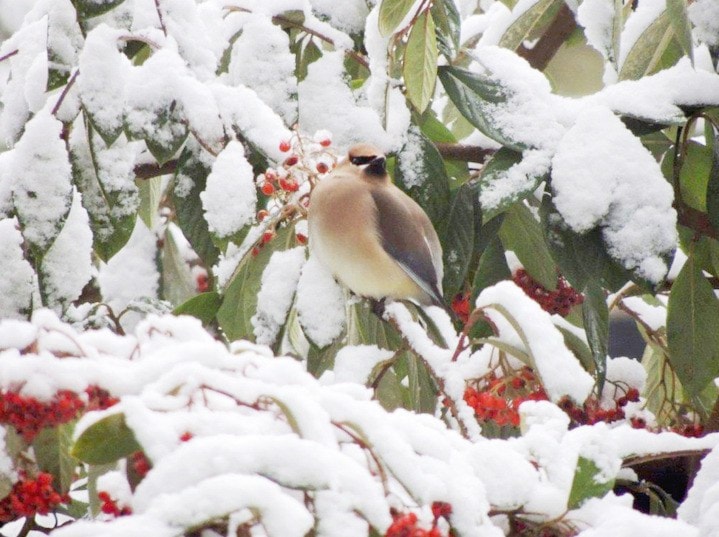It’s hard to know where to begin. The garden is full of birds and red berries are disappearing quickly. The amazing flurry of activity is due to a foot of snow packed on the ground and it’s not going anywhere. There’s nothing much else to eat except last fall’s Cotoneaster and Holly berries. Although they don’t have a lot of nutrition, they have been sweetened and softened by the frost. Anything is better than nothing.
Given the nature of coastal weather, this snow could be all gone in a few days but right now it’s time to enjoy the show. Red robins in red berries. Crested Cedar Waxwing in high alder; Northern Flicker flashing rusty-red underwings; Red-breasted Sapsucker poking at the hemlock; Song Sparrow singing; Dark-eyed Juncos sparring and all’s right with the world.
The cold north-easter slips along Dixon Entrance toward Delkatla Wildlife Sanctuary and is holding winter’s grip in place. Ducks huddle together for warmth until the sun rises over the hill — which it always does, even if it’s cloud-hidden. It’s hard to focus on this column with all the surrounding activity and now a Varied Thrush, all orange and black, has joined the melee. There will be some casualties from the cold of course. This is not weather for the faint-hearted.
Why are all the birds here? It’s mid-March and they are eager to get to their nesting grounds further north. They have to get on with the business of raising the next generation. But it’s cold up there too, so things are in a bit of a holding pattern. A few Red Crossbills have now appeared. They are early nesters and are showing up in small flocks of three to five.
So why are red birds red? Good question. Nobody really knows for sure, but recent studies suggest it has a lot to do with diet and attractiveness for mating success. According to one source, “red pigments must be manufactured physiologically by birds, because unlike yellow ones, for example, they cannot be obtained directly from their diet. But two separate studies have identified a single gene that codes for an enzyme that converts yellow pigments to red ones… the enzyme is produced in large quantities in the liver. Producing all of that enzyme probably takes a lot of energy, and only the fittest, strongest birds are likely to be able to produce enough of it.”
So, the fittest survive to reproduce and the more colourful they are, the more attractive they are to one another. It’s only a human hypothesis of course. We do these studies because if we didn’t, we’d have to admit we know nothing.
We are in and of the world. It’s quite a place, especially when, while crossing on the Kwuna this week, we could see birds in layers along the water as far as the eye could see. It was incredible and quite possibly the largest group of Common Murres seen here. Western Grebes, Pacific Loons and Red-throated Loons were visible to the horizon. We stopped to count from the highway and as we looked a snowstorm swept across the water. Everything faded into white. Total bird count: 10,000. Snowflakes: 50 gazillion.
